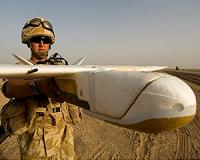| . |  |
. |
Denver CO (SPX) Aug 27, 2010 Rockwell Collins have unveiled the results of successful flight tests with dramatically increasing levels of damage on an unmanned F/A-18 subscale model air vehicle. The results were discussed during a news briefing at AUVSI's Unmanned Systems North America 2010 exhibition in Denver. The Defense Advanced Research Projects Agency (DARPA) sponsored the flight demonstrations held this summer at the Aberdeen Proving Ground in Maryland. One of the flight tests involved ejecting 60 percent of the right wing, 30 percent of the right fin rudder and 30 percent of the right stabilizer. Despite the damage, the UAV remained steady in-flight and was able to land. Another flight test demonstrated the ability for the aircraft to continue to fly a fixed trajectory and land safely after the engine was turned off. A final flight test involved ejecting 80 percent of the UAV's right wing. In that flight test, the UAV was also able to land safely. Previous testing had involved ejecting up to 60 percent of the wing. All flight tests included auto take off and landing. Dave Vos, senior director of Rockwell Collins Control Technologies and Unmanned Aircraft Systems, said the next step is to port this technology onto an operational UAV. "This latest flight test campaign is an important step toward our ultimate goal of offering our damage tolerance control software to the UAV market," said Vos. "Our solution improves the survivability of UAVs in theater, while simultaneously improving the reliability of UAVs flying in civilian airspace. By detecting and instantly and automatically compensating for failure or damage in flight, UAVs and manned aircraft can soon achieve coexistence." Damage tolerance is an enabling capability for increasing the mission reliability of UAVs operating in hazardous and high-threat environments. The technology provides for real-time autonomous accommodation of damage, followed by an adaptation process that alters the flight control system to compensate for the effects of the damage. During the flight tests, Rockwell Collins demonstrated a capability that could be applicable to all military aircraft operating in combat environments and to commercial, business and general aviation aircraft for full flight automation and backup. Other maneuvers demonstrating failure and immediate automatic recovery through damage tolerance controls that were conducted during this summer's flight tests include: + Locking the right aileron in neutral position in-line with the rest of the airplane, which caused an uncontrolled roll. + Engine idle test - engine command is idle, which means there is no throttle up or down.
Share This Article With Planet Earth
Related Links Rockwell Collins UAV News - Suppliers and Technology
 Upgraded Surveillance Aircraft Arrive In Afghanistan
Upgraded Surveillance Aircraft Arrive In AfghanistanLondon, UK (SPX) Aug 27, 2010 Upgraded Desert Hawks - hand-launched, remote-controlled surveillance aircraft which can record video footage day and night, sending it directly to troops on the ground - have arrived in Afghanistan. The latest version of the Desert Hawk has been bought as part of a GBP3m Urgent Operational Requirement to provide a further boost to the surveillance capability on the front line. The D ... read more |
|
| The content herein, unless otherwise known to be public domain, are Copyright 1995-2010 - SpaceDaily. AFP and UPI Wire Stories are copyright Agence France-Presse and United Press International. ESA Portal Reports are copyright European Space Agency. All NASA sourced material is public domain. Additional copyrights may apply in whole or part to other bona fide parties. Advertising does not imply endorsement,agreement or approval of any opinions, statements or information provided by SpaceDaily on any Web page published or hosted by SpaceDaily. Privacy Statement |